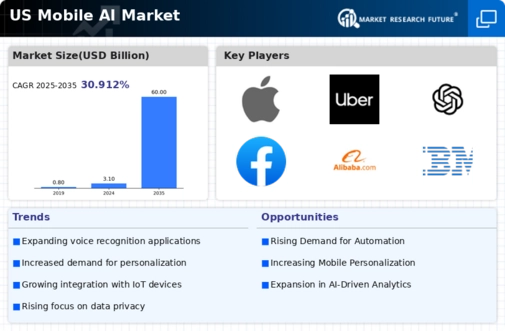The competitive landscape of the US Mobile AI Market is characterized by rapid technological advancements, innovative applications, and a dynamic mix of established firms and emerging startups. With an increasing consumer demand for enhanced user experiences, businesses are investing heavily in artificial intelligence capabilities that can streamline operations, improve customer interactions, and offer personalized services. The competition within this sector is fierce, as players seek to differentiate themselves through unique product offerings, strategic partnerships, and robust marketing strategies.
As mobile devices become an integral part of daily life, the integration of AI technologies into mobile applications is reshaping how users interact with their environments, leading to significant shifts in market dynamics and opportunities for growth.Apple has firmly established itself as a dominant player in the US Mobile AI Market with its robust ecosystem that seamlessly integrates AI across its devices and applications. The company benefits from its strong brand loyalty and a substantial user base that trusts its commitment to privacy and security.
Apple's strengths lie in its proprietary AI technologies, such as Siri and advanced machine learning algorithms embedded in its mobile devices, which enhance user experience through intuitive voice control and personalized recommendations. By prioritizing user engagement and satisfaction, Apple has created a cohesive experience that fosters customer retention and drives ongoing innovation. Its vast application ecosystem allows third-party developers to leverage Apple's AI capabilities, thereby ensuring continuous enhancements to the mobile AI landscape.Uber operates in the US Mobile AI Market with a focus on transforming urban mobility through the implementation of advanced AI technologies.
The company's core product offerings, including ride-hailing, food delivery, and freight services, leverage AI to optimize routes, predict demand, and improve overall service efficiency. Uber's strength lies in its extensive data capabilities, enabling it to refine its algorithms continuously and provide users with personalized experiences. The company's strategic initiatives include various partnerships and acquisitions that enhance its technological infrastructure, such as the acquisition of AI-driven startups that bolster its machine learning and data analytics capabilities.
By integrating AI into its services, Uber not only optimizes operational efficiencies but also enhances customer experience with features like real-time tracking and personalized ride options. This commitment to innovation reinforces Uber's competitive edge in the ever-evolving mobile AI landscape in the US.























